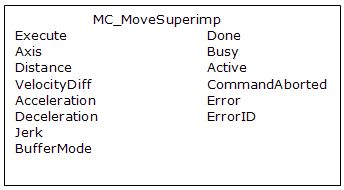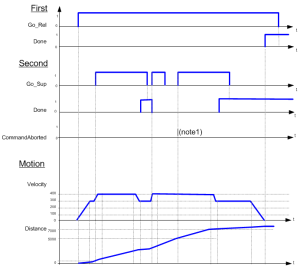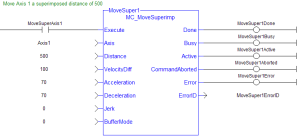 Function Block
Function Block![]() A function block groups an algorithm and a set of private data.
It has inputs and outputs. - Performs a single-axis move superimposed upon the currently executing move.
A function block groups an algorithm and a set of private data.
It has inputs and outputs. - Performs a single-axis move superimposed upon the currently executing move.
- Commands a controlled motion of a specified relative distance additional to an existing motion.
- The existing Motion is not interrupted
 An asynchronous signal from hardware indicating the need for attention or a synchronous event in software indicating the need for a change in execution., but is superimposed by the additional motion.
An asynchronous signal from hardware indicating the need for attention or a synchronous event in software indicating the need for a change in execution., but is superimposed by the additional motion.
Inputs
|
Input |
Data Type |
Range |
Unit |
Default |
Description |
|---|---|---|---|---|---|
|
Execute |
BOOL |
0, 1 |
N/A |
No default |
On the rising edge |
|
Axis |
AXIS_REF |
1, 256 |
N/A |
No default |
Name of a declared instance of the AXIS_REF library function
|
|
Distance |
LREAL |
No range |
User units |
No default |
Distance. |
|
VelocityDiff |
LREAL |
No range |
User unit/sec |
No default |
|
|
LREAL |
No range |
User unit/sec2 |
No default |
Trapezoidal: Acceleration rate. S-curve: Maximum acceleration. |
|
|
Deceleration |
LREAL |
No range |
User unit/sec2 |
No default |
Trapezoidal: Deceleration rate. S-curve: Unused. |
|
LREAL |
No range |
User unit/sec3 |
No default |
Trapezoidal: 0 (zero). S-curve: Constant jerk. |
|
|
BufferMode |
SINT |
0, 5 |
N/A |
No default |
|
Outputs
|
Output |
Data Type |
Range |
Unit |
Description |
|---|---|---|---|---|
|
Done |
BOOL |
No range |
N/A |
Indicates the move completed successfully. |
|
Busy |
BOOL |
No range |
N/A |
High from the moment the Execute input goes high until the time the move is ended. |
|
Active |
BOOL |
No range |
N/A |
Indicates this move is the Active move. |
|
CommandAborted |
BOOL |
No range |
N/A |
Indicates the move was aborted. |
|
Error |
BOOL |
No range |
N/A |
Indicates either:
|
|
ErrorID |
INT |
No range |
N/A |
Indicates the error if Error output is TRUE. |
Remarks
-
- This function block starts a motion-related action and stores data for calculations and error checking.
See Call Function Blocks Multiple Times in the Same Cycle if using a dual-core controller.
- See Function Blocks - General Rules about how inputs and outputs work.
- See Main about how this function is used in the Hole punch project.
Usage
This function block:
- Provides a way to smoothly apply a shift in axis position while it is executing a move.
- Is commonly used with MC_TouchProbe for performing position corrections on the slave axis in a Mark-to-Machine registration application.
-
- MC_MoveSuperimp performs a similar function to the SlaveOffset input in the MC_CamIn function block.
It has the additional features of setting the velocity, acceleration, deceleration, and jerk motion parameters.
- A superimposed move is executed similar to a MC_MoveRelative move using the specified Distance, Velocity, Acceleration, Deceleration, and Jerk values.
- The interpolated command generated by a superimposed move is added to the command of the currently executing move.
- Subsequent calls to MC_MoveSuperimp can abort or blend to an executing MC_MoveSuperimp move.

Figure 1: MC_MoveSuperimp
Time Diagram
Figure 2: Time Diagrams: First and Second FBs
Figure 3: Time Diagram
-
- The CommandAborted is not visible here because the new command works on the same instance.
See Pipe Network - General Rules. - The end position is between 7000 and 8000, depending on the timing of the aborting of the second command set for the MC_MoveSuperimposed.
FBD Language Example
Not available.
FFLD Language Example
IL Language Example
Not available.
ST Language Example
(* MC_MoveSuperimp ST example *)
Inst_MC_MoveSuperimp( MovSupReq, Axis1, 123.555, 10.0, 100.0, 100.0, 0, 0 );
MovSupDone := Inst_MC_MoveSuperimp.Done; //store Done output into user defined variable
See Also









